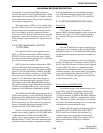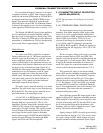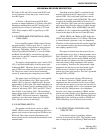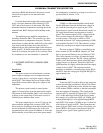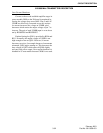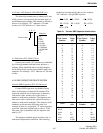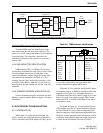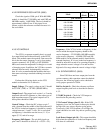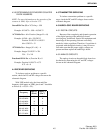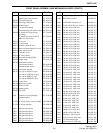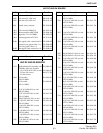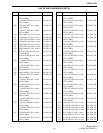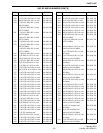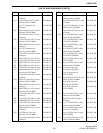
SERVICING
4-4
February 2001
Part No. 001-9800-001
4.3.2 REFERENCE OSCILLATOR (U806)
Check the signal at U806, pin 8. With 800 MHz
models, it should be 17.500 MHz, and with UHF and
900 MHz models, 14.850 MHz. The level should be
approximately 400 mV rms. If this signal is not
present, replace the reference oscillator because it is
not serviceable.
4.3.3 VCO MODULE
The VCO is a separate assembly that is covered
by a metal shield and soldered directly to the RF PC
board. This module cannot be repaired. One reason for
this is that the center frequency is set by laser tuning
ceramic resonator L101 (UHF) or L907 (800/900
MHz) and cannot be readjusted if it changes as a result
of changing a part. In addition, the VCO has a ceramic
substrate that can easily be damaged by excessive
heat. It is also recommended that modules that have
been removed using a standard soldering iron not be
reused.
Perform the following checks on the VCO
module to determine if it is defective.
Supply Voltage - The supply voltage at pin 15 should
be 5.0 VDC (UHF) or 7.0 VDC (800/900 MHz).
Output Level - The output level on pins 1 or 2 can be
measured with an RF voltmeter or some other type of
high-impedance meter. The typical output level at
these points should be 0 dBm.
Control Voltage - Check the DC voltage on pin 7
with a channel near the middle of the band selected. If
the VCO is locked on frequency, it should be a steady
voltage between 1.1 and 5.2 volts. If it is not locked
on frequency, it should be near the lower (1.1 V) or
upper (5.2 V) end of its range.
Frequency Shift Inputs - The pin shift signals on
pins 4 and 3 should be as follows (L = 0V, H = 5V):
Frequency - If the VCO is locked on frequency, in the
receive mode the output frequency should be the
receive frequency – 52.950 MHz (800 MHz models)
or the receive frequency – 45 MHz (UHF and 900
MHz models). In the transmit mode it should be the
transmit frequency. If it is not locked on frequency, it
should be near the low end of its operating frequency
range when the control voltage is low and near the
high end of its range when the control voltage is high.
4.3.4 SYNTHESIZER IC (U804)
Since U804 does not have output pins from the
various counters, their operation cannot be checked.
However, the following signals can be checked to
verify proper operation of U804.
Ref Osc In (pin 8) - Check the reference oscillator
output frequency and level as described in Section
4.3.2.
VCO RF In (pin 6) - Check the VCO output as
described in the preceding section.
VCO Control Voltage (pins 13, 14) - If the VCO
frequency is too low, the signal on these pins should
be high with very narrow negative-going pulses.
Conversely, if the VCO frequency is too high, the
signal should be low with very narrow positive-going
pulses.
Lock Detect Output (pin 18) - This output should be
high when the synthesizer is locked on frequency and
low when it is unlocked.
Mode
Shift 1
(Pin 4)
Shift 2
(Pin 3)
UHF MODELS
Rx Mode 430-449 MHz L L
449-470 MHz H L
470-491 MHz L L
491-512 MHz H L
Tx Mode 430-449 MHz L H
449-470 MHz H H
470-491 MHz L H
491-512 MHz H H
800/900 MHz MODELS
Normal Mode H L
Talk-around Mode L H



